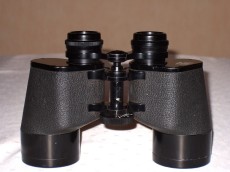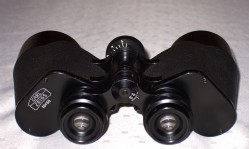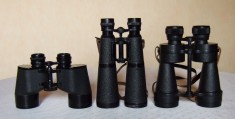

Many of the binoculars sold during the 1950s and 1960s were actually based on earlier military models of the WWII era. Modifications, if any, were only moderate, including a variation of the ocular design, a replacement of the individual eyepiece focuser with the rather comfortable central focuser, and the addition of single-layer anti-reflection coatings, a technology which was occassionally applied to optical instruments of the wartime era and which became the standard for binoculars of the 1950s.
Since 10x50 had established itself as a military standard for high power hand-held observations, it is no surprise to find the same specification abundant on the after-war civilian market as well. A classical example was the Zeiss Jena Dekarem (Jenoptem), a design of the 1930s, which turned into one of the most successful consumer binoculars in history and remained in production until the mid 1990s (its ocular construction was updated in the late 1940s). The Ross Stepmur and the Hensoldt Dialyt are further examples of civilian binoculars of military heritage. In contrast, the Zeiss (Oberkochen) was designed from scratch during the mid 1950s and remained a civilian binocular throughout its production period.
Fig.1: The Zeiss (Oberkochen) 10x50 (about 1970)
Towards the end of WWII, Zeiss (Jena) was taken over by the Soviets, whereas a second branch was set up in the Western Zone of occupation to become the 'Zeiss-Opton Optische Werkstaette Oberkochen GmbH'. The work on binoculars resumed immediately thereafter, so that in 1954 the first new Porro type model, the Zeiss 8x30, was introduced. As can be verified on this list, the first of the 50 mm models, the 7x50, appeared in 1956, followed by the 8x50 and 10x50 in 1957. The latter was touted as 'Jahrhundertglas' ('glass of the century'), employing air-spaced tele-objectives and a novel wide angle 2-1-2 ocular design, named 'Zeiss Astroplanar'. Among the most striking features of this instrument are its wide angle of field, the short but wide ('stubby') body design and its oversized focusing wheel located at the objective end of the central hinge. This binocular was produced until about 1971, and its price at that time was about 890 DM. In the early 1980s a special edition, which covered 1000 samples, was sold at much higher price. Nowadays, this glass is available second hand for typically 450 Euro.
Fig. 2: The Hensoldt Dialyt 10x50 (about 1955)
Hensoldt developed its Dialyt series, with the typical slim body featuring the roof prism design, as early as 1905. According to Seeger's book ("Military Binoculars and Telescopes for Land, Air and Sea"), the first 10x50 ('Mountain Dialyt') was introduced in 1910 and in service during WWI, and the predecessor of the binocular (Fig. 2) was an individually focused military binocular and in production from 1936 to 1943. Early versions were using a Dialyt-Pentaprism for image reversal, later, the Abbe-Koenig design was implemented. The civilian Dialyt was made between 1948 and 1963, and the one to be tested here was made around 1955. I was informed by a reader of this review that later versions of this series, of the 1960s, were of improved performance in terms of field of view and stray light protection. With only 720g, this binocular was of amazingly low weight. According to this list, the price of the Dialyt in 1961 was 197 US $ (or 468 DM), slightly higher than that of the Diagon 10x50 (175 US $). Today, this binocular is sometimes found on the second hand market and sold between 300 and 400 Euro, depending on condition.
Fig. 3: The Ross Stepmur 10x50 (about 1960)
According to Seeger (Military binoculars ...), Ross made binoculars of Porro II design from the 1920s onwards. In some devices of the WWII era, not only the prisms were cemented together, but also the field lens of the ocular was cemented onto the prism. This led to a reduced number of air-to-glass transits and, with the absence of anti-reflection coatings, to a significant increase of light transmission and hence low light performance. Around 1930, Ross introduced its first civilian binocular, the 7x50 Stepnite, and the 10x50 Stepmur was perhaps a later modification of this prototype. It is featuring rather large wide angle oculars, and its characteristic body shape allows to position the hands comfortably in front of the prism housings during observation. Seeger has pointed out that in later designs by Ross, the prisms and field-lenses were separated again, maybe because the single-layer coating had by then been established and the transmission advantage of cemented surfaces had diminished, considering the tight manufacturing tolerances inherent in this design. Ross was taken over by Avimo in the 1970s. The 10x50 Ross Stepmur is sometimes offered on the second hand market for roughly 300 Euro.
 Fig. 4: The Zeiss (Porro I design), Hensoldt Dialyt (roof design)
and Ross Stepmur (Porro II design)
Fig. 4: The Zeiss (Porro I design), Hensoldt Dialyt (roof design)
and Ross Stepmur (Porro II design)
The following table summarizes some of the specifications of the contenders.
| Real angle | Apparent angle | Eye relief | Exit pupil | Weight | |
| of view (deg) | of view (deg) | (mm) | diam. (mm) | (kg) | |
| Hensoldt Dialyt 10x50 | 5.4 | 54 | 12 | 5.0 | 0.72 |
| Ross Stepmur 10x50 | 7.0 | 70 | 14 | 5.0 | 1.00 |
| Zeiss (Oberkochen) 10x50 | 7.4 | 74 | 9 | 5.0 | 1.02 |
Image sharpness: The central resolution of all three binoculars is fine enough so that stars are imaged as proper point-like structures. It may well be the case that a most critical investigation using resolution charts would reveal a certain deficiency of resolution with the Dialyt as a result of a missing phase-shift correction coating (which was invented in the late 1980s only), and it might be that ambitious bird watchers were able to see the difference to Zeiss or Ross (which, being of Porro design, do not suffer from such a phase shift). In my field tests and without using resolution charts I was unable to make out any significant difference in center resolution, but there exist plenty of differences off center. Through the Zeiss and the Hensoldt, the points begin to display some blur from about 75% toward the edge of the field. Particularly for the Zeiss, this is an excellent result, considering its wide angle of field. The Ross displays the same amount of aberrations at about 60% off center, which is normal for wide angle binoculars. During daytime, the image through both the Zeiss and Hensoldt is close to perfect almost throughout, except for the outermost (radial) 10-15%. The Ross displays some visible blur over the outermost 25% of the field.
Image color: Despite of its age, the Dialyt seems to have an absolutely neutral color rendition. This is remarkable since there are several effects known to modify the color rendition over the decades, e.g. the decomposition of the canada balm which is used to cement lens elements together, or the ageing of the mirror layer required in ordinary roof prism designs. However, the Hensoldt was already using the Abbe-Koenig prism which exclusively employs total reflection of the light beam, significantly improving the overall transmission. The Ross and the Zeiss both show a slight but non-offending yellowish tint.
Rectilinear distortion: A moderate pincushion distortion helps to neutralize the globe effect, an apparent 'rolling' of the image when panning over a distant scenery. Since the early 1950s such a pincushion distortion was therefore routinely implemented in both civilian and military binoculars, and it is clearly visible in the three contenders. It appears that the amount of distortion may be somewhat less with the Ross, without any negative impact on its panning characteristics.
Fig. 5: Exit pupils of Zeiss (left), Hensoldt (center) and Ross (right)
Stray light: Stray light emerges whenever light enters the eye through any non-regular path, i.e. a path which differs from the theoretical ray-trace of the optical design. In many cases, such light enters through large angles from sources outside the field of view and is somewhere reflected back into the light path. As a result, the contrast and hence the definition of the image is suffering. It is instructive to study the exit pupils of different binoculars when light of an extended source (here: sky) is entering the instrument (Fig. 5): As is clearly visible, the exit pupils of both the Ross (right) and Hensoldt (center; note the glowing prism edge framing the exit pupil) are surrounded by illuminated structures. These are called 'prism leaks' or 'side pupils'. Since these binoculars have 5mm exit pupils and the human's eye pupils are smaller than that during daytime, these prism leaks have no negative consequences for daytime observations. Under low light, however, the pupils are expanding to a size of up to 7mm and begin to catch light from these side pupils. As a consequence, both the Hensoldt and the Ross display stray light as soon as the sun is setting and the sky still has left some residual glow. Only at very low light, this effect vanishes as a result of the darkening sky. The stray light problem is worse with the Ross, limiting the application spectrum of this instrument to daytime (or nighttime with absence of light sources). The Zeiss however (left image) is perfectly shielded against stray light. This can be achieved with the installation of internal baffles, proper prism covers and an effective light absorbing finish of the tube walls. As a result, the Zeiss displays a perfect contrast under practically any light condition.
Ghost images: Technically, ghosting is also a form of stray light, but of entirely different origin: If a bright light source is positioned into the field, reflections on the air-to-glass surfaces take place, which can lead to multiple 'ghost' images of the light source. Such an effect is most easily observable during nighttime with a point-like light source (e.g. a street lantern), but the same effect takes place at daytime as well and leads to a reduction of contrast. The successful suppression of this type of reflections is an indicator for the quality of anti-reflection coating. Since these three binoculars were made before 1978 (the year of introduction of multi-layer coating), their single-layer coatings are unable to fully suppress ghosting from bright light sources. The Zeiss performs best, it displays several ghosts of moderate intensity. These images remain localized and do not significantly affect the overall contrast of the image. Only at very high light intensities the contrast goes down as a result of a glow, probably produced at the air spaced objectives. The Ross has got some ghosts which cover major parts of the image and hence affect its definition. Even worse is the performance of the Hensoldt, which produces some reflections of high intensity. Additionally, light which is diffracted at the roof edges is causing a spike like effect whenever a bright point source is observed.
Low light performance: Along with this test I had spent plenty of hours inside a forest at nighttime, with some residual light from the moon. I have made the following observation: Compared with the Ross, the Hensoldt's image appeared a little bit brighter. Obviously, its light transmission was superior, for whatever reason. Nevertheless, the Ross allowed to observe at least as many details as the Dialyt. It was possible to pin down two reasons for that. Firstly, the field of view of the Ross was significantly wider. This helped to identify objects more easily in their environmental context. Secondly, the Ross offered an improved impression of depth, which helped to identify the three dimensional composition of the image. As long as there is sufficient residual light, the 3-D impression is supported by structures on the curved surfaces of three dimensional objects. This aid is absent once the light becomes too low to identify fine structure on surfaces. At this point, the true three dimensional perception as a result of triangulation is gaining significance, and here the wider triangular basis of the Porro design when compared to the roof (objective distance at 65mm ocular distance: 14cm (Zeiss), 11cm (Ross), 7.5cm (Hensoldt), compare with Fig. 4) is significant. Objects of very low contrast, e.g. animals between trees and bushes, could be identified with the help of the three dimensional context of the image, which was easier when using the Zeiss or Ross than observing the rather flat image of the Hensoldt. The image of the Zeiss was about as bright as the Hensoldt's, but its wider angle and far superior impression of depth led to a significantly improved performance under very low light. I think that this observation is not without relevance, considering the fact that in the community of hunters, slim roof prism night glasses (typically 8x56) with small fields of view are most popular. I now believe that a similar Porro design with as wide as possible field would make a much better night glass than most of these narrow roof prism binoculars. The same is true for military applications, of course: The excellent 3-D impression of Porro binoculars with widely spaced objectives is likely to improve their performance under very low light conditions.
| Angle of | Image | Stray | Ghost | Low | Image | Mechanical | Final | |
| field | sharpness | light | image | light | color | construction | score | |
| Hensoldt Dialyt 10x50 | 1 | 2.5 | 2 | 1 | 1.5 | 3 | 2 | 13 |
| Ross Stepmur 10x50 | 2 | 1 | 1 | 2 | 1.5 | 1.5 | 2 | 11 |
| Zeiss (Oberkochen) 10x50 | 3 | 2.5 | 3 | 3 | 3 | 1.5 | 2 | 18 |
The 'final score' is the sum of the individual scores and is intended to serve as an orientation only.
Without any doubt, the Zeiss (Oberkochen) is the strongest binocular of the competition. It has got a very wide angle of field with an impressive degree of aberration control, is perfectly shielded against stray light, and comes with a compact and fairly light weight construction. The body shape and the position of its focuser make it most comfortable to use. The term 'glass of the century' is more than marketing hype: At the time of its introduction (1957), this was the best 10x50 binocular on the market, and it was able to hold this position until the 1980s, when Zeiss (Jena) introduced the Nobilem, which I would rate a little stronger optically, but which was also significantly more heavy and bulky. If this binocular were available with modern coatings, and perhaps with increased eye-relief, then it were able to compete with todays high end contenders of Leica, Fujinon and Swarovski.
The strength of the Hensoldt Dialyt is its low weight construction. Optically, it is a little inferior to the Diagon Porro design which was produced by Hensoldt during the same time period. The color rendition of this binocular, almost 50 years after production, is still close to neutral, and the aberrations are well controlled even at the peripheral regions of the field, which is, however, somewhat narrow. The Dialyt also displays some ghosting problems. Perhaps, not all optical surfaces were coated, or the quality of coating was inferior.
The Ross Stepmur is an interesting binocular. It is of a performance level similar to the Dialyt's, but with its own merits. Its oculars are the most comfortable ones among the three contenders, and their large field of view is easily seen over. Its body is comfortably and steadily held with two hands, but the position of the focuser is inconvenient. This binocular has got a serious stray light problem, not under daylight, but as soon as light is low so that the pupils start touching the peripheral region of the exit pupil, and this is a limiting factor for the spectrum of application of this instrument.
Zeiss (Oberkochen) 10x50 on Fan Tao's page
Ross Stepmur 10x50 on Fan Tao's page
Last updated: Dec. 2006